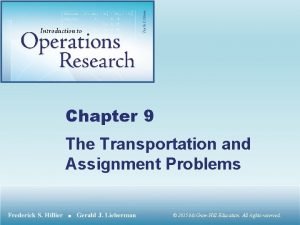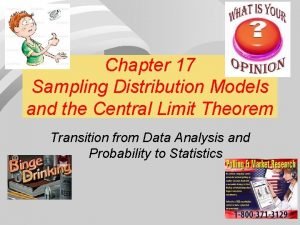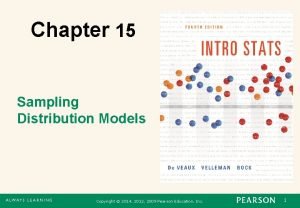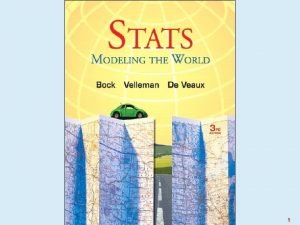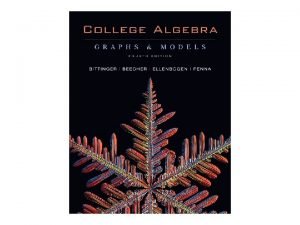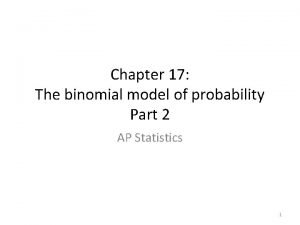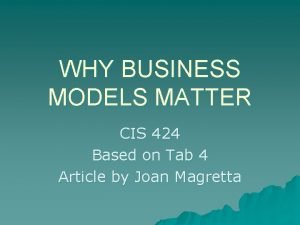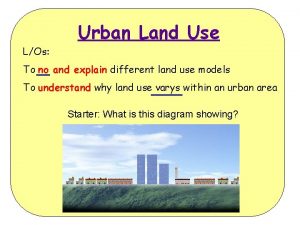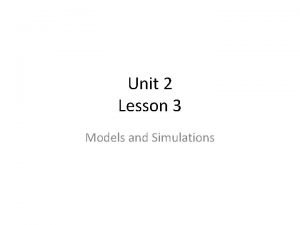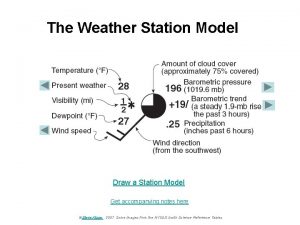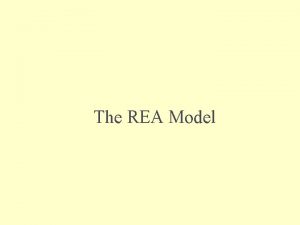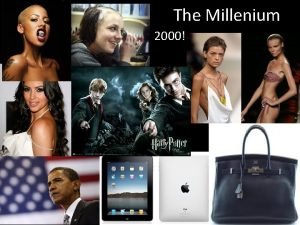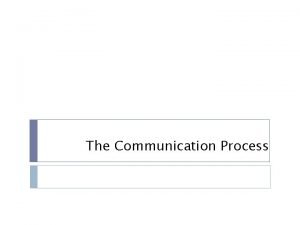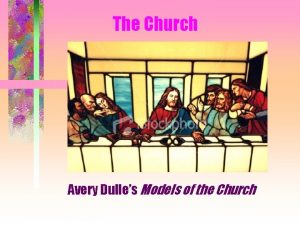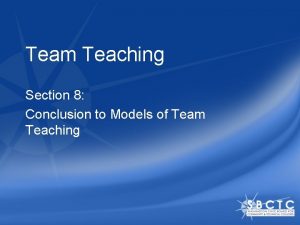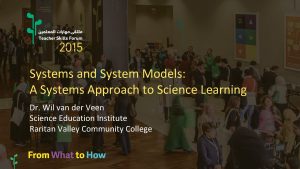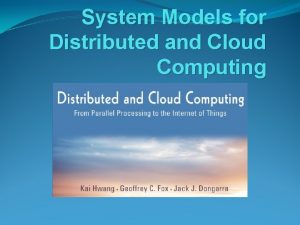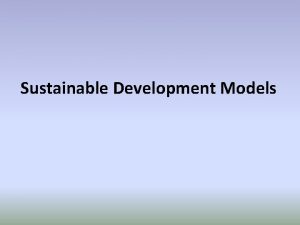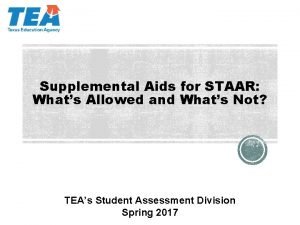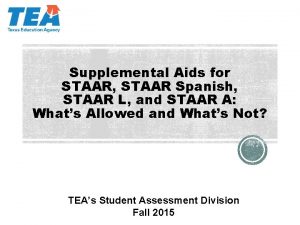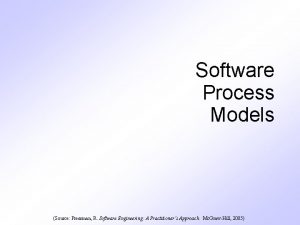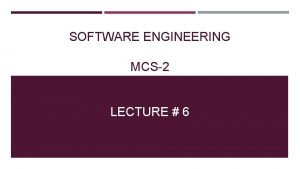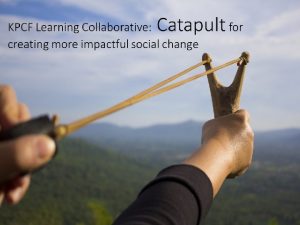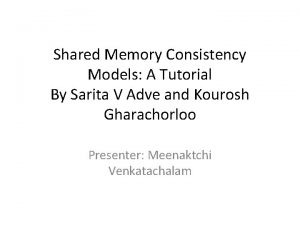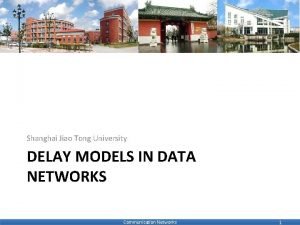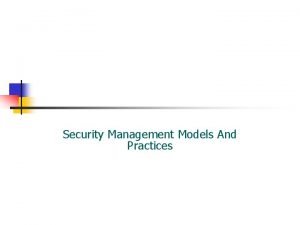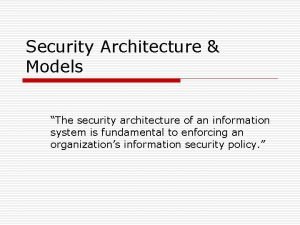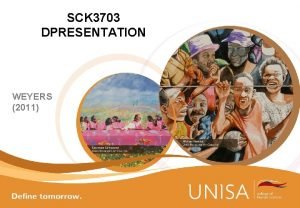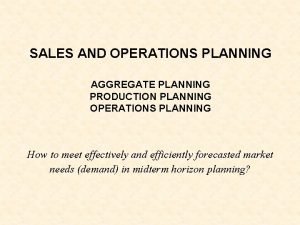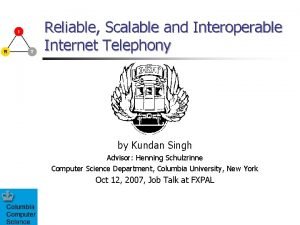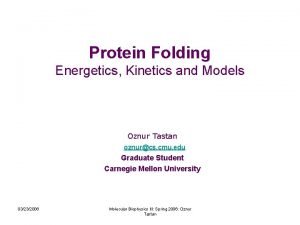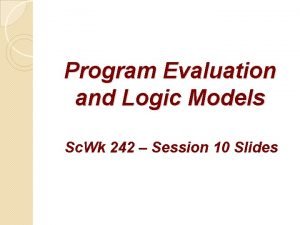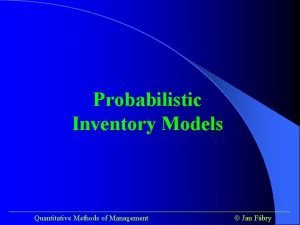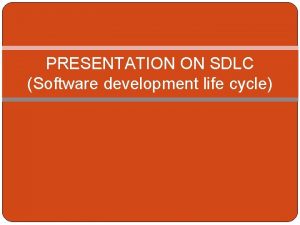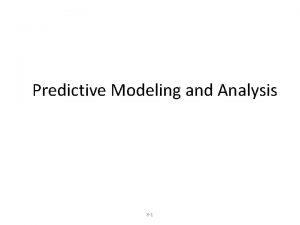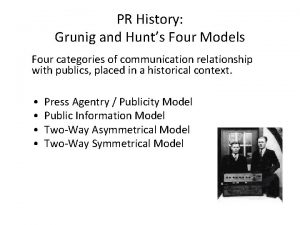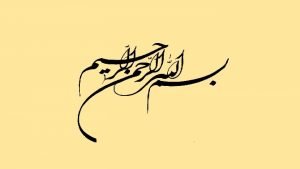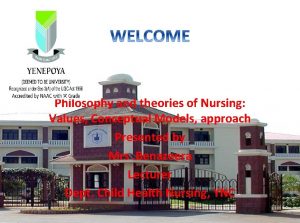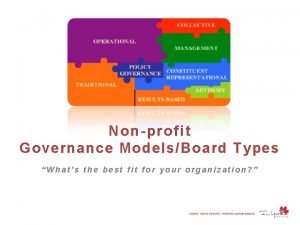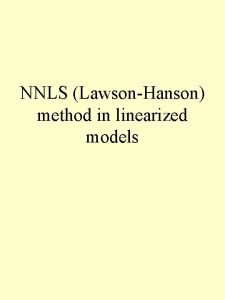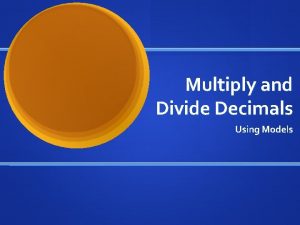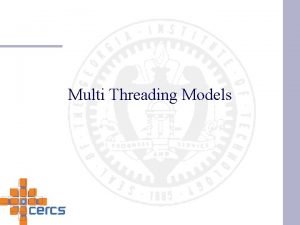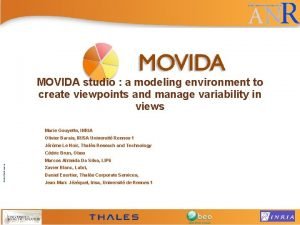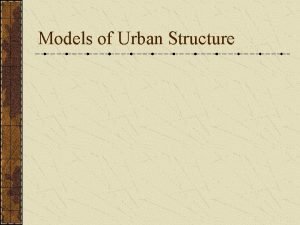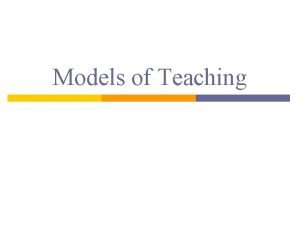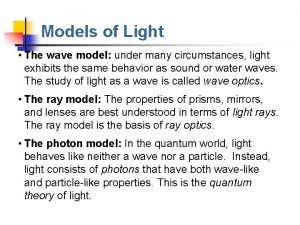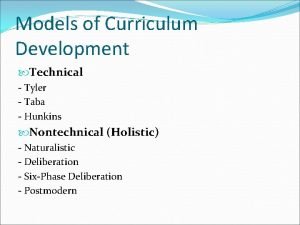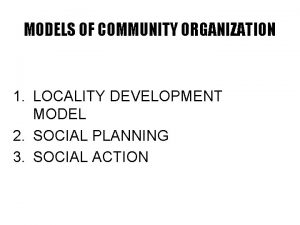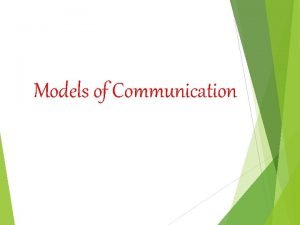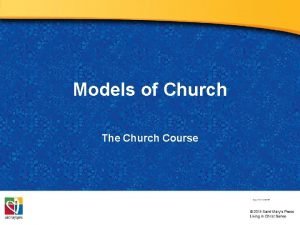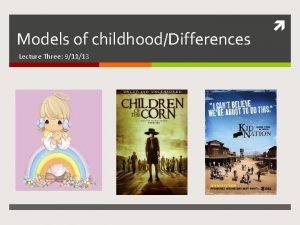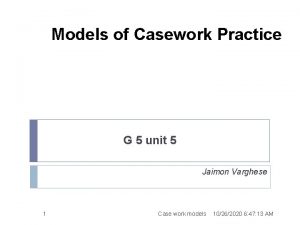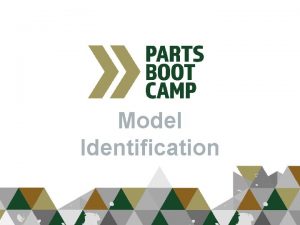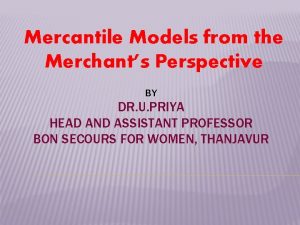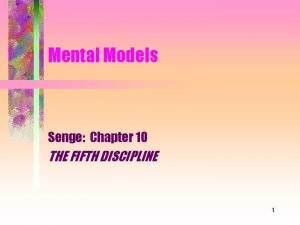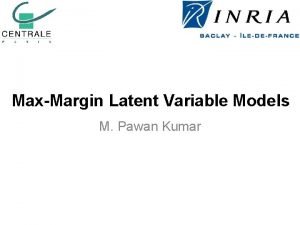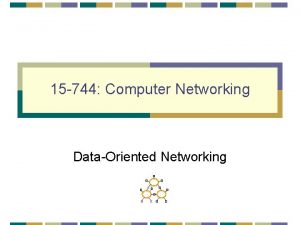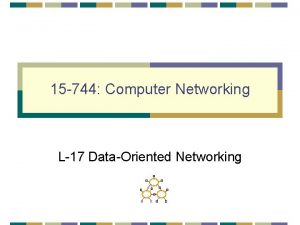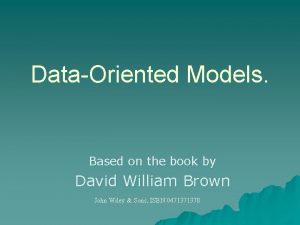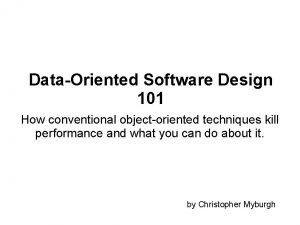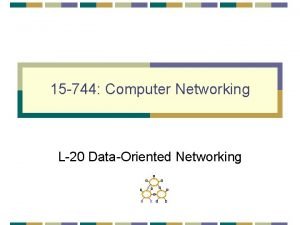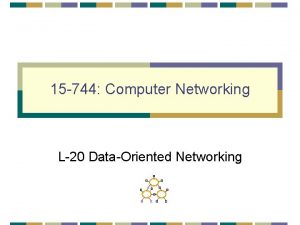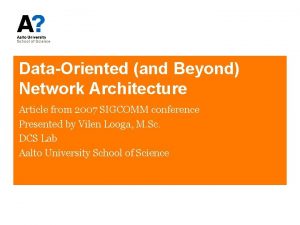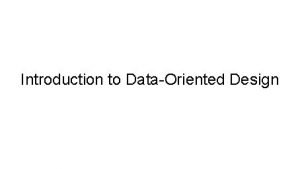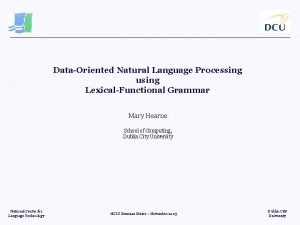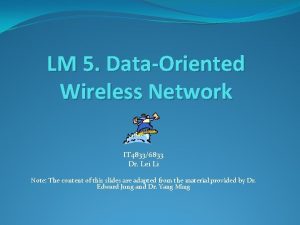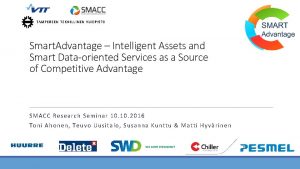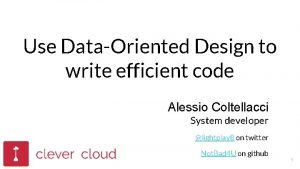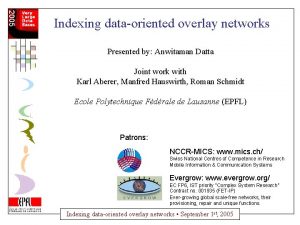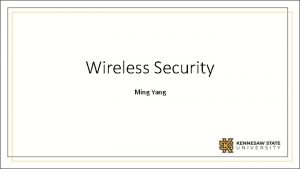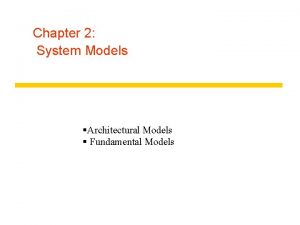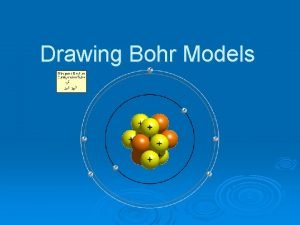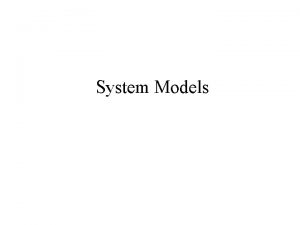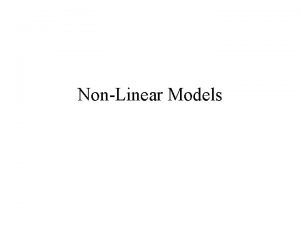Chapter 4 DataOriented Models 1 66 Chapter 4


































































- Slides: 66

Chapter 4 Data-Oriented Models 1 / 66

Chapter 4 Data-Oriented Models l 4. 1. l 4. 2. l 4. 3. l 4. 4. l 4. 5. l 4. 6. l 4. 7. Data Models: The ERD Entity-Relationship Modeling Object-Oriented Models An Introduction to Objects Object-Oriented v. s. Object-Based Conceptual, Logical & Physical Models as Communication Tools 2 / 66

4. 1. Data Models: The ERD l Mid-1970 s: Databases were just coming into use l Research to find ways to model data l To give template for database design l Many notations were tried l Chen (1976) proposed the Entity-Relationship Diagram (ERD) 3 / 66

The ERD was the first systems analysis tool to focus on DATA and How it is Linked and Organized. It was from this that objects then evolved. 4 / 66

4. 1. Data Models: The ERD l. Chen made two contributions: n The Entity-Relationship Principle, and n The Entity-Relationship Notation. l These further issues were also investigated by Chen and others: n E-R models for database design n The significance of the data of an enterprise n Data as a corporate n The stability asset. of the data of an enterprise 5 / 66

4. 2. Entity-Relationship Modeling The following six points all relate to both E-R and Object modeling. Now let’s examine them in this order: The Entity-Relationship Principle. E-R models for database design. The stability of data. The significance of data. Data as a corporate asset. Entity-Relationship Notation. 6 / 66

The Entity-Relationship Principle. l The E-R principle focuses on the things we need to keep data about. l Earlier methods emphasized what the users need to know to do their job. l Here we emphasize what things the users need to know about. l The word Entity means a thing. l Later we worry about what items they need to know about each entity. 7 / 66

The Entity-Relationship Principle. A Data Entity is something that has separate and distinct existence in the world of the users and is of interest to the users in that they need to keep data about it in order to do their job. 8 / 66

The Entity-Relationship Principle. We define: Entity Type An is a class or category expressing the common properties that allow a number of entities to be treated similarly. 9 / 66

The Entity-Relationship Principle. l Entity types are always singular. l So our entity lists look like this: Sales l. Customer l. Product l. Sales clerk Phone l. Customer l. Number l. Line l. Call l. Service All Singular Booking l. Venue l. Artist l. Agent l. Concert l. Performance l. Customer l. Seat 10 / 66

The Entity-Relationship Principle. An individual Customer or Product or Sale or Call or Artist is then an Occurrence of the Entity Type. 11 / 66

The Entity-Relationship Principle. l. Attributes are the data elements carried by an entity that describe it and record its state. l. Attributes are things we need to know about an Entity. 12 / 66

The Entity-Relationship Principle. Associations: We define: An Association is the interaction of two entities and is represented by a verb. 13 / 66

The Entity-Relationship Principle. Associations : l The purpose is to provide access paths to the data. l When a sale occurs, we will link: A Customer To a Product To a Sales Clerk. l Using a verb to describe each link. 14 / 66

The Entity-Relationship Principle. Associations: In this way we are able to diagram the structure of our user’s business data, independent of any way that the data may be used, either now or in the future. 15 / 66

The Entity-Relationship Principle SUMMARY l An Entity is a thing the users need to know (i. e, record) something about. l An Entity Type is a group or class of entities that are all the same kind of thing. l An Occurrence of an Entity Type is a specific individual thing of the kind the Entity Type describes. l Attributes are things we need to know about an Entity. l An Association is the interaction of two Entities and is represented by a verb. l These interactions among the Entities (i. e. , these associations) show us the pathways we need to follow through the database to access the data. 16 / 66

E-R models for database design. There is a very significant reason why Entities, Attributes and Associations are so fundamentally important for systems development. 17 / 66

E-R models for database design. For database design: l Each Entity becomes a file or table. l Each Attribute becomes a field (i. e. , a column) l Each Association becomes an access pathway (i. e. , a foreign key) 18 / 66

The Stability of Data. This tells us that Data Entities Are Stable Over Time. 19 / 66

The Stability of Data. l However, entities are neither static nor stagnant; l There may be an occasional new entity, l There will often be new attributes, l But as long as we stay in the same business there will be very few new entities. 20 / 66

The Stability of Data. This stability contributes greatly to reducing the costs and delays in system maintenance. 21 / 66

The Stability of Data. However, beware new business! Mergers, acquisitions, takeovers and diversifications can all put your company into new businesses with a host of new entity types. 22 / 66

The Significance of Data. The Data modeler’s Creed: Data is the Centre of the Universe 23 / 66

Data as a Corporate Asset. l Since data is something the users must have in order to work, l It can rightly be regarded as a Business Asset or Resource l Just like s s s Finance Human Resources Plant and Equipment Vehicles Inventories Etc. 24 / 66

Data as a Corporate Asset. Like any corporate asset, there are some basic functions that must be done as part of managing the asset: l Acquisition l Organizing, storing and safekeeping l Deployment, on time, to the people who need it l Disposal when no longer needed 25 / 66

Data as a Corporate Asset. l This has led to two new functions in the information industry, Data Administration (DA) and s Data Resource Management (DRM). s l DA is a middle-management function concerned with finding and documenting every data element the company uses. l DRM is a high-level management function, involving long-term strategic planning. DRM reports to the CIO (Chief Information Officer; in a well-organized company the CIO is a vice-president). 26 / 66

Data as a Corporate Asset. l The focus of DA and DRM is to manage data as we would manage any other business resource. l The ERD has been the tool used to understand, document and administer data. l As of now, the Object Model is taking over this function. 27 / 66

The Entity-Relationship Notation. l There are many E-R notations. l All of them work, any will do the job. l Use whichever one you or your boss or your professor or your client prefers. l UML is now the standard notation in the object world, so l We will use UML for our Entities as well as our Objects. 28 / 66

The Entity-Relationship Notation. Entities l Draw an Entity as a square or rectangular box, divided by a line near the top. l Above the line place the name, singular. Student 29 / 66

The Entity-Relationship Notation. Attributes l If there are not too many, Attributes may go in the bottom part of the box. l Primary key first, marked with an asterisk. l If not enough room, show only the key, list the others in the accompanying write-up. Student *Student No. Name Age Sex 30 / 66

The Entity-Relationship Notation. Associations: l Draw a line joining two entity boxes to show a relationship exists l Write the verb above the line. l Add a solid arrowhead so that it makes a sentence when you read it in the direction of the arrow: l “Student enrols in course” Student *Student No. Name Age Sex Course Offering Enrolls In *Course No. *Date Room No. Max Enrol 31 / 66

The Entity-Relationship Notation. Associations College *Name Address Phone Rating Employs Student *Student No. Name Age Sex Instructor *Employee No. Name Age Sex Salary teaches Course Offering Enrols In *Course No. *Date Room No. Max Enrol 32 / 66

The Entity-Relationship Notation. More Examples of Associations Product *Prod No. Description Unit Price Qty in Stock buys Customer *A/c No. Name Address Phone No. Balance “Customer buys Product” Driver *Employee No. Name Wage Sex Bus drives “Driver drives Bus” *Bus No. Make Model Seating Read the sentence in the direction of the arrow. 33 / 66

The Entity-Relationship Notation. Multiplicity l The critical thing we need to know is Is it One, or Is it Many? l This is the Multiplicity of the relationship (also called cardinality). 34 / 66

The Entity-Relationship Notation. Multiplicity l We diagram this by adding a star (asterisk) below the relationship line whenever it should show “many. ” l Read this one as “Instructor teaches many course offerings” Instructor *Employee No. Name Age Sex Salary Course Offering teaches * *Course No. *Date Room No. Max Enrol 35 / 66

The Entity-Relationship Notation. Multiplicity l We refer to this as a “One-to-Many” Association, or 1: M Instructor *Employee No. Name Age Sex Salary Course Offering teaches * *Course No. *Date Room No. Max Enrol 36 / 66

The Entity-Relationship Notation. Multiplicity l And, since we wish many Customers to buy many Products, l This one is a Many-to-Many association, or Product *Prod No. Description Unit Price Qty in Stock M: M buys * * Customer *A/c No. Name Address Phone No. Balance 37 / 66

The Entity-Relationship Notation. Multiplicity l There are numerous other symbols also used for the “many” end of a relationship, l including single and double arrows, etc. l The star (asterisk) is the UML standard. l Other ERD notations have their own ways to show “many” and what direction to read the sentence. 38 / 66

The Entity-Relationship Notation. Summary l There are many ERD notations. We are using UML since it has become the official world standard object notation. l An entity is a square box, with a singular name above a horizontal line. l The primary key attribute is below the line, with an asterisk ( * ) l Other attributes are listed below or on another page. ctd. . . 39 / 66

The Entity-Relationship Notation. Summary l An association is a line joining two entities. l Write the verb above the line, with arrowhead. l Reading in the direction of the arrow, entity-verb-entity should make a simple sentence. ctd. . . 40 / 66

The Entity-Relationship Notation. Summary l Multiplicity is one (straight line) or many (asterisk) below each end of the line. 1: M * M: M * * 41 / 66

4. 3. Object-Oriented Models l Object-Oriented Programming (OOP) is now the state of the art. Pool of C programmers C++ n Everybody now learns Java n l Object-Oriented Analysis and Design (OOA&D) are still very much the leading edge. l Object-Oriented Databases (OODBMS) are powerful and rapidly catching up. l RDBMSs are going O-O. 42 / 66

4. 3. Object-Oriented Models l Object-Oriented Development Environments so far are mostly Object. Oriented Front Ends that link to a relational database. l They are truly O-O only in the GUI. l They are evolving toward true O-O, l And so are the relational databases! n ORACLE 9 i permits O-O. 43 / 66

4. 4. An Introduction to Objects l Like an entity, an object is described by a noun, thing l And it is “Some in the user’s world that has a separate and distinct existence, and is of interest in that they need to keep data about it. ” 44 / 66

4. 4. An Introduction to Objects l But an object is more than an entity. l In addition to the data, the object carries program code, l That uses or changes that data. 45 / 66

4. 4. An Introduction to Objects The only way that a program can read or change the data carried by an object, or access the data in any way at all is by invoking one of the defined pieces of program code that the object carries within itself. 46 / 66

4. 4. An Introduction to Objects This can be illustrated with a Taylor Donut Diagram: e er et m el o D ust C Jo Name Address Here Phone No 555 Balance $1. 49 Pri n Ba t lan ce t Lis Up Ba date lan ce Cr e Cu ate sto me r Ch a Ad nge dre ss ge an No Ch one Ph ge n a Ch e m Na all Customer 47 / 66

4. 4. An Introduction to Objects l The “behaviors” around the outside are subroutines or functions. l They physically are pieces of compiled program code. l In the real world they correspond to things this object can do or have done to it. 48 / 66

4. 4. An Introduction to Objects l These are called variously: s s s Functions Behaviors Operations Services Responsibilities Methods (esp. at the OOP level) l The data in the center is surrounded and protected by them. 49 / 66

4. 4. An Introduction to Objects l Thus, as Coad and Yourdon put it, n An object encapsulates both “the data, and the exclusive functions on that data. ” n By “exclusive” we mean that no other code can access or manipulate this data. 50 / 66

4. 4. An Introduction to Objects l So our task as Analysts is to investigate the users’ business to find: The objects and their classes s Their attributes and associations s The operations that can be performed on, to, with or by these objects. s l Then we check how each operation will use or affect TUGAS the data attributes. • Analisa Objek dan l In the Design asosiasinya dari unitphase bisnis we produce specifications for each operation. Yang anda interview l In Coding we use these specifications to write them as • Analisa menggunakan methods in whatever OOPL we chose. UML class diagram • kirim ke ocal_sophan@yahoo. com paling lambat 5 hari 51 / 66

4. 4. An Introduction to Objects l OOPLs and OODBMSs actually store the program code for the methods in the database along with the data. l We write small pieces of code, each to do a single operation. l A Customer object will need: An operation called Update. Address s A piece of code to carry it out s This code is then attached to the object in the database. 52 / 66

4. 4. An Introduction to Objects l When an object is first created, it appears as a collection of fields (attributes) in RAM. l Some are deleted after a short lifetime. l Some disappear when the machine is turned off. l These are all Transient Objects, which DO NOT survive beyond the current session. 53 / 66

4. 4. An Introduction to Objects l Some objects we need to keep around longer Customers s Employees s Products, etc. s l i. e. , all the things we normally would expect to put in a database. l These we create as Persistent Objects, that DO survive beyond the current session. 54 / 66

4. 4. An Introduction to Objects Summary l Objects are entities (things that carry data) with behavior (operations) added. l These operations exclusively access the data it carries - no other code can touch it. l Operations are coded in an OOPL or OODBMS as methods (functions, subroutines). l Code for the methods is stored in the database along with the data for the object. l Any program that wants data from this object can get it only by calling one of the methods defined on this object. 55 / 66

4. 4. An Introduction to Objects Summary l Transient Objects are created by OOPLs in the RAM of the computer and DO NOT Survive the current session. l Persistent Objects are stored by a database (OODBMS) and DO Survive beyond the current session. 56 / 66

4. 5. Object-Oriented vs Object-Based l Some programming languages have objects but do not qualify as Object-Oriented. n e. g. ADA 85, Clipper l To be truly O-O, they must have two important features: n. Inheritance, and n. Polymorphism (These are defined and fully explained in Chapter 8) l These two features account for a great deal of the power and benefits of O-O methods. 57 / 66

4. 6. Conceptual, Logical & Physical Models l There a variety of modeling paradigms available: DFDs, ERDs, Objects, etc. l Each can be done at three levels. l These are three different levels of abstraction: Conceptual Logical Physical 58 / 66

4. 6. Conceptual, Logical & Physical Models A physical model is the final design document showing how things will be written, done or built, and depicting all hardware and software platform details, including data storage and data transmission media. 59 / 66

4. 6. Conceptual, Logical & Physical Models At the logical level, we build a model that shows everything that must be included, and everything that the system must do, without specifying how. It makes no reference to choices of hardware, software or media. A logical model shows what a system must do or have, without regard for how it is to be done, built or represented. 60 / 66

4. 6. Conceptual, Logical & Physical Models A Conceptual Model is a representation of the users’ business in terms of their conception of how it operates. For ERDs and Object models, this means it includes M: M associations. 61 / 66

4. 6. Conceptual, Logical & Physical Models l We begin by working with the users to produce a conceptual model. l Then we expand that into a logical model by adding all the features that were not apparent to the users. l Finally we make all our design decisions and document them on the physical model. 62 / 66

4. 7. Models as Communication Tools l Users always accuse us “technoids” of speaking in a foreign tongue. l They complain that: “Those computer people never listen to us, ” n or “They never do what we were asking for” n or “They gave us way more than we needed” n or “They can never explain in English how to make it work. ” n 63 / 66

4. 7. Models as Communication Tools l To build an accurate model, it is essential that you are user-driven in your modeling. l The difference between a good systems analyst and a great one is in people skills, especially listening skills. l “God gave us two ears and one mouth!” l Remember, we are using our object-oriented techniques to understand their business. 64 / 66

4. 7. Models as Communication Tools l Once the users learn the notation, they quickly take to using the model to discuss and solve problems with the analysts. l All players on the team and sometimes outside it can make use of these models. 65 / 66

End of Chapter 4 66 / 66
 Modals and semi modals
Modals and semi modals Hungarian algorithm worksheet
Hungarian algorithm worksheet Chapter 17 sampling distribution models
Chapter 17 sampling distribution models Ap stats chapter 17 sampling distribution models
Ap stats chapter 17 sampling distribution models Ap stats chapter 17 sampling distribution models
Ap stats chapter 17 sampling distribution models Chapter 1 graphs functions and models answers
Chapter 1 graphs functions and models answers Chapter 17: probability models
Chapter 17: probability models Why business models matter
Why business models matter Axe molecular geometry
Axe molecular geometry Using recursion in models and decision making
Using recursion in models and decision making Using recursion in models and decision making sheet 3
Using recursion in models and decision making sheet 3 L
L Math models unit 9 lesson 1
Math models unit 9 lesson 1 Station models
Station models Revenue cycle rea diagram
Revenue cycle rea diagram Linear interactional and transactional
Linear interactional and transactional Size 0 models
Size 0 models Traditional response hierarchy models
Traditional response hierarchy models The models of the church
The models of the church Conclusion for models of teaching
Conclusion for models of teaching Adtran ont models
Adtran ont models Systems and system models
Systems and system models Explain system models for distributed and cloud computing
Explain system models for distributed and cloud computing Atkisson pyramid model example
Atkisson pyramid model example Blank graphic organizers for staar
Blank graphic organizers for staar Pictorial models of geometric figures
Pictorial models of geometric figures Staar l
Staar l Primary nursing care delivery model
Primary nursing care delivery model Waterfall model pressman
Waterfall model pressman Evolutionary software process models
Evolutionary software process models Social service delivery models
Social service delivery models Shared memory consistency models: a tutorial
Shared memory consistency models: a tutorial Delay models in data networks
Delay models in data networks Security management models
Security management models Security architecture model
Security architecture model Weyers 2011
Weyers 2011 Production planning model
Production planning model Kundan switches models
Kundan switches models Argument models
Argument models Florys models
Florys models Types of logic models
Types of logic models Inventory model in quantitative techniques
Inventory model in quantitative techniques Software development life cycle presentation
Software development life cycle presentation Logic driven model
Logic driven model Grunig's 4 models of pr
Grunig's 4 models of pr Examples of physical models
Examples of physical models List of nursing conceptual models
List of nursing conceptual models Nonprofit board governance models
Nonprofit board governance models Nn ls models
Nn ls models Multiplying decimals using area models
Multiplying decimals using area models Multithreading models
Multithreading models Studio movida
Studio movida Concentric zone model
Concentric zone model Cooperative learning
Cooperative learning Models of light
Models of light Advantages and disadvantages of hilda taba model pdf
Advantages and disadvantages of hilda taba model pdf Models of community development
Models of community development Disadvantages of berlo's model of communication
Disadvantages of berlo's model of communication Models and images of the church
Models and images of the church Models of childhood
Models of childhood Models of casework
Models of casework Social goal model in group work
Social goal model in group work Clark serial number decoder
Clark serial number decoder Mercantile model from the merchant perspective
Mercantile model from the merchant perspective Peter senge mental models
Peter senge mental models Self-paced learning for latent variable models
Self-paced learning for latent variable models Marketing analytics strategic models and metrics
Marketing analytics strategic models and metrics

